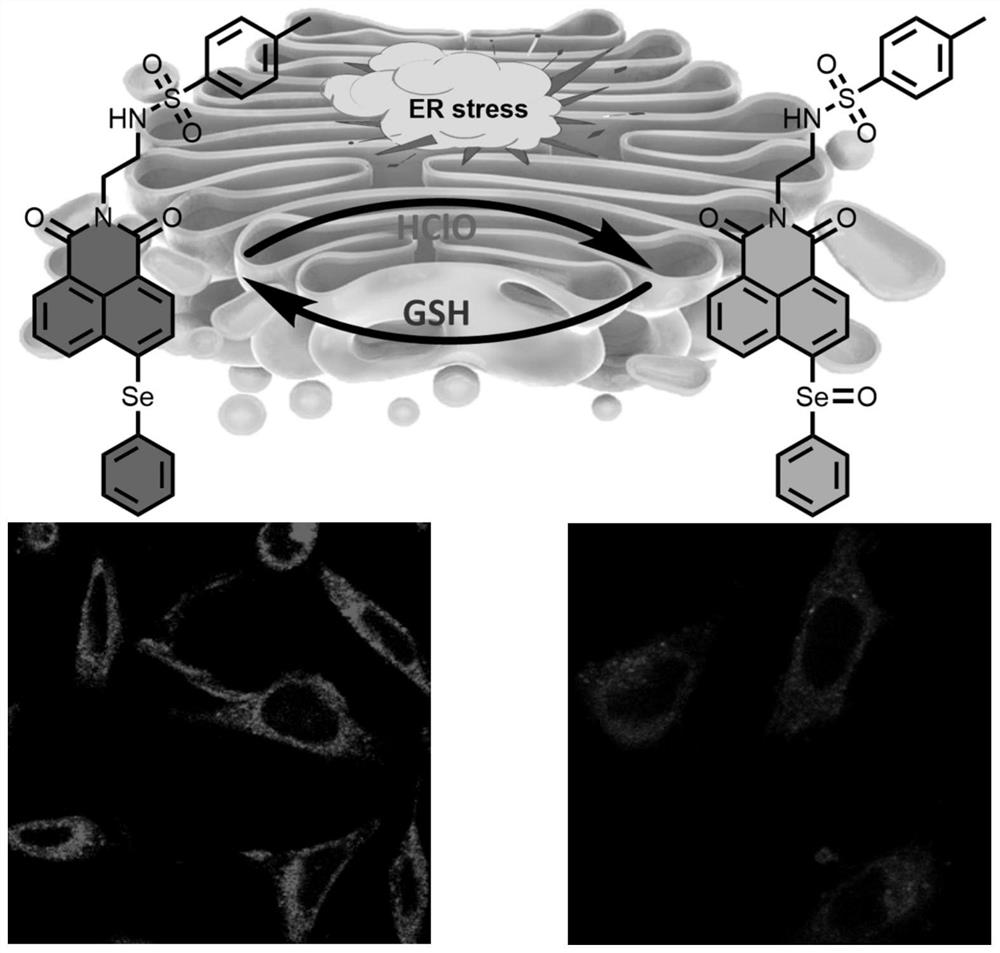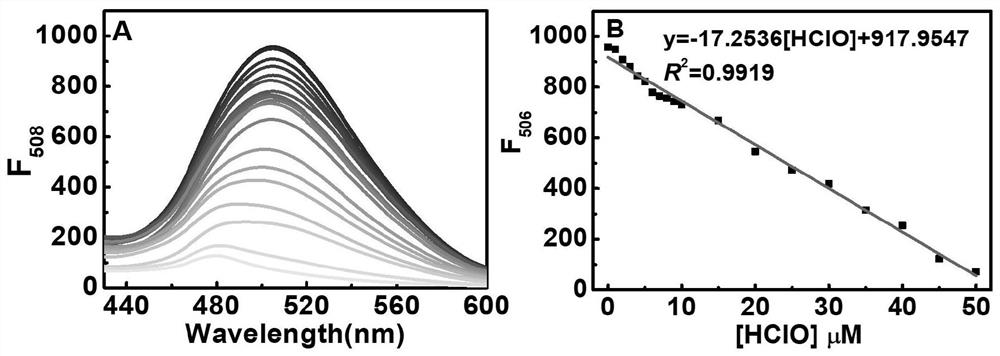Preparation and application of endoplasmic reticulum targeted redox reversible fluorescent probe
A fluorescent probe, endoplasmic reticulum technology, applied in fluorescence/phosphorescence, chemical instruments and methods, luminescent materials, etc., can solve the problem of not realizing endoplasmic reticulum redox reversible monitoring and other problems, achieve few steps, high sensitivity, easy The effect of preparation
- Summary
- Abstract
- Description
- Claims
- Application Information
AI Technical Summary
Problems solved by technology
Method used
Image
Examples
Embodiment 1
[0033] Synthesis of fluorescent probes
[0034] Dissolve diphenyldiselenide (624.3mg, 2mmol) in 15mL of absolute ethanol, add sodium borohydride (37.83mg, 1mmol), and stir at -5~0°C under nitrogen protection until the solution becomes clear. Dissolve 4-bromo-N-(2-aminoethyl)-4-methylbenzenesulfonamide-1,8-naphthalimide (473 mg, 1 mmol) in 5 mL of absolute ethanol and add to the above reaction solution , continue to react for 12 hours, warm up to room temperature, distill off the solvent under reduced pressure, and purify on silica gel to obtain the target probe (86.5%). The characterization results are as follows: HRMS(ESI):m / z[M] + The theoretical value is 550.0465, and the test results in m / z[M+H] + 551.0454. 1 HNMR (400MHz, DMSO-d 6 ):δ=8.53-8.62(m,1H),8.44-8.53(m,1H),8.19-8.32(m,1H),7.87-7.96(q,1H), 7.70-7.82(s,1H),7.53 -7.67(m,5H),7.41-7.50(m,3H),7.16-7.25(d,2H),3.23-3.50(t,2H),3.03-3.13(t,2H),2.17-2.30(s, 3H). 13 C NMR (100MHz, DMSO-d 6 ): δ=163.63,142.87,141.02,...
Embodiment 2
[0036] Fluorescence titration experiment of probe to hypochlorous acid
[0037] Add 10 μM probe into the mixed system of acetonitrile and phosphate buffer (v / v=1:99, pH=7.4), and then add hypochlorous acid so that the concentrations of hypochlorous acid are 0, 1, 2, 3, 4, 5, 6, 7, 8, 9, 10, 15, 20, 25, 30, 40 and 50 μM, measure the fluorescence intensity at each concentration after the reaction time ends, the fluorescence curve is as follows figure 2 (A) shown. Such as figure 2 As shown in (B), as the concentration of hypochlorous acid increases, the fluorescence intensity of the probe at 506 nm gradually decreases, and the detection limit is calculated to be 0.85 μM.
Embodiment 3
[0039] Selectivity Experiment of Fluorescent Probes for Hypochlorous Acid
[0040] Add 50 μM hypochlorous acid and other activity analysis interferers (50 μM concentration) to the 10 μM probe system, and the detection system is a mixed system of acetonitrile and phosphate buffer (v / v=1:99, pH=7.4), Measure the fluorescence intensity of different reaction systems, calculate the fluorescence intensity, the results are as follows image 3 shown. It can be seen from the figure that the probe only responds to hypochlorous acid, and has a good response to hypochlorous acid in the presence of other analytical interferences. The experimental results show that the probe has good selectivity and anti-interference to hypochlorous acid ability.
PUM
 Login to View More
Login to View More Abstract
Description
Claims
Application Information
 Login to View More
Login to View More - R&D
- Intellectual Property
- Life Sciences
- Materials
- Tech Scout
- Unparalleled Data Quality
- Higher Quality Content
- 60% Fewer Hallucinations
Browse by: Latest US Patents, China's latest patents, Technical Efficacy Thesaurus, Application Domain, Technology Topic, Popular Technical Reports.
© 2025 PatSnap. All rights reserved.Legal|Privacy policy|Modern Slavery Act Transparency Statement|Sitemap|About US| Contact US: help@patsnap.com



